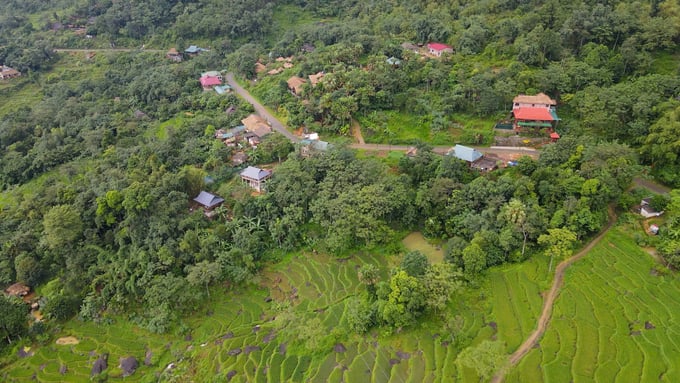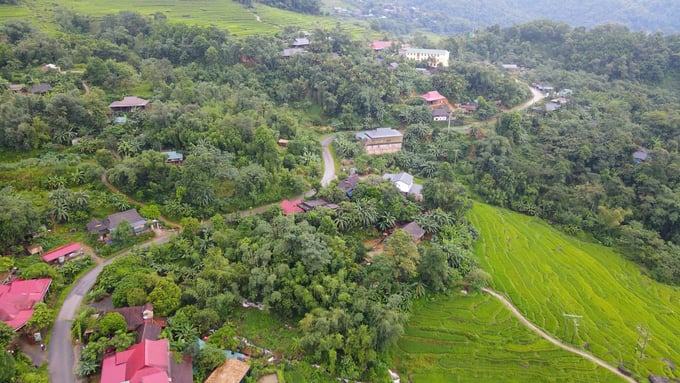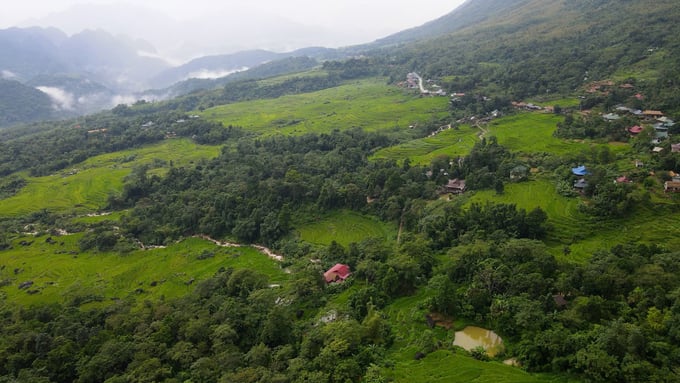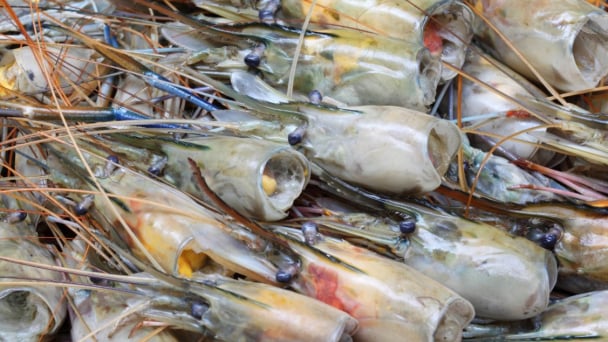May 31, 2025 | 23:12 GMT +7
May 31, 2025 | 23:12 GMT +7
Hotline: 0913.378.918
May 31, 2025 | 23:12 GMT +7
Hotline: 0913.378.918

Pu Luong mountains and forests. Photo: Pham Huy.
Although this season is not the most beautiful Pu Luong, the natural scenery of the highlands of Thanh Hoa is enough for people to admire.
Pu Luong is as beautiful as a young girl in the countryside. Dr. Hoang Sy Thinh (Vietnam National University of Agriculture) could not hide his emotions as a first-time visitor to Pu Luong and exclaimed especially when the car passes through hairpin bends. On one side is the mountainside, and on the other is a deep stream through the rice fields in their prime. The Thai and Muong people's simple, rustic, traditional stilt houses are hidden under the canopy of the green bamboo forest.
The people's natural scenery and cultural identity are invaluable resources for developing community tourism, the Doctor from the Vietnam Academy of Agriculture analyzed. More specifically, Pu Luong retains its pristine, rustic beauty in agricultural and rural tourism, gradually becoming a trend. It is not yet invaded by too much concrete, restaurants, and hotels like in many other places. "If there is a methodical strategy, Pu Luong will certainly be a leading interesting destination in the agricultural and rural tourism field," Dr. Thinh pondered.

Mrs. Lo Thi Hoai, Head of Kho Muong Community Tourism Group. Photo: Pham Huy.
In the evening, after more than 4 hours and a distance of nearly 160km from Hanoi, we arrived at Thanh Son commune, Ba Thuoc district, a Thai community that has lived for generations in the core area of Pu Luong Nature Reserve. Ordering dinner and accommodation at the Kho Muong village community tourism group, Mrs. Lo Thi Hoai, owner of Tho Ha Homestay and also the head of the village tourism group, quickly explained like a professional tour guide: Pu Luong Nature Reserve has a total area of more than 17,000 hectares, spanning two districts of Ba Thuoc and Quan Hoa in Thanh Hoa province, of which the core area is about 13,000 hectares.
In recent years, thanks to the advantages of natural landscapes and ethnic cultural identity, the community tourism model in Pu Luong has developed quite rapidly. The Ba Thuoc district has 57 destinations, of which Pu Luong has 19. In Thai, Pu Luong means the highest mountain peak. Dinner was quickly prepared. There was Co Lung stream duck, rock snails, bitter leaf soup, wild banana flower salad, Thanh Son hill chicken... Mr. Ngam Van Tho, Mrs. Hoai's husband, prepares all local products.
After drinking, he told us that the couple were both teachers at Thanh Son Primary School, and in the past, they only thought that community tourism was something somewhere else, not here. One day, a group of foreign tourists came to Pu Luong, they wandered around to learn about the natural landscape, the cultural identity of the people, and then asked them to cook for them. Gradually, more groups of tourists came to Kho Muong, the houses and gardens were renovated to be more suitable, and many other households in the village were mobilized to serve tourists.

The beauty of Pu Luong. Photo: Pham Huy.
Community tourism in Kho Muong was formed from that. Along with culinary services from local products, the cultural identity of the ethnic people has also been gradually restored through each dance and song, brocade weaving, or simply dressing up in the traditional costumes of the ethnic people that had been lost. Now, the community tourism group led by Mrs. Hoai has mobilized 7 households to participate. In addition to homestay accommodation services and activities serving tourists, the group members also connect with local people to consume and promote local agricultural products.
For example, the Co Lung duck is a rare breed of duck that only exists in Pu Luong, raised by Thai people in fields and streams and living close to nature, so the meat is firm, lean, low in fat, and very fragrant. Or the stone snail dish the local people grope in every rock hole in the forest, which is only available in Pu Luong during the rainy season. The snails eat seaweed all year round, steamed with ginger fish sauce or lemongrass, creating an irresistible aroma that visitors will never forget after experiencing it once.
Mrs. Hoai said people turn landscapes, culture, and local products into assets thanks to community tourism.The mandarin oranges that used to grow abundantly in the fields are now also a “tourism ambassador” of Pu Luong. People pick them to use as spices for dishes, soak them in wine or use the peel to make tea, or soak the fruit in honey… Families earning hundreds of millions of dong from this fruit used to have little economic value.

Green Pu Luong. Photo: Pham Huy.
According to Mrs. Hoai, visitors who want to experience nature can visit the Doan Street Market, Kho Muong Village, Don Village... In recent years, the most favored journey for tourists has been walking through the core area of the conservation area, camping overnight in Don Village, and enjoying the peaceful beauty of the Cham stream flowing through the valley. Or conquering Pu Luong peak over 1,700m high, experiencing terraced fields, at the end of October, people will enter the harvest season, also the mountains and hills will be dyed golden yellow, mixed with the green of the forest, no different from a fairyland.
After a day and night of experience in Pu Luong, Dr. Hoang Sy Thinh shared: Although there are still some difficulties in foreign language communication, policies, and investment capital for community tourism development, Pu Luong is like a sleeping princess in the forest that the people are awakening.
"If synchronous planning and timely support policies exist, Pu Luong will shine," Dr. Thinh shared.
Translated by Huong Giang

(VAN) Seafood by-products are opening a new path, combining green growth and technological innovation to enhance the industry's value.

(VAN) Mr. Nguyen Thanh Cong, Vice Chairman of the Son La Provincial People's Committee, reflects on Son La’s journey from barren hills to fruitful orchards after a decade of hard work.

(VAN) FAO’s Director-General addresses the 5th Baghdad International Water Conference.
/2025/05/26/1716-4-nongnghiep-191706.jpg)
(VAN) Chain linkages, technological innovation, and raw material zoning are three strategic pillars for the coconut industry to strongly develop and elevate its position on the global agricultural map.
![Advanced mariculture – an inevitable trend: [4] Accompanied by scientists](https://t.ex-cdn.com/nongnghiepmoitruong.vn/608w/files/sohk/2025/05/13/1941-pgsts-vo-van-nha-140958_717.jpg)
(VAN) According to Assoc. Prof. Dr. Vo Van Nha, Director of the RIA III, the development of advanced offshore mariculture is no longer an option but an essential path for Vietnam’s fisheries sector.

(VAN) Vietnam is intensifying the development of mollusk farming areas that meet international standards, aiming for sustainable growth and enhancing its export position in the global seafood market.
![Advanced mariculture – an inevitable trend: [3] Policy-driven momentum](https://t.ex-cdn.com/nongnghiepmoitruong.vn/608w/files/doanhtq/2025/05/21/0104-0616-0348-nuoi-bien-170339_789.jpg)
(VAN) To ensure the success of offshore mariculture that uses advanced technologies, it is essential to establish supportive policies that inspire both individuals and enterprises to invest with confidence.